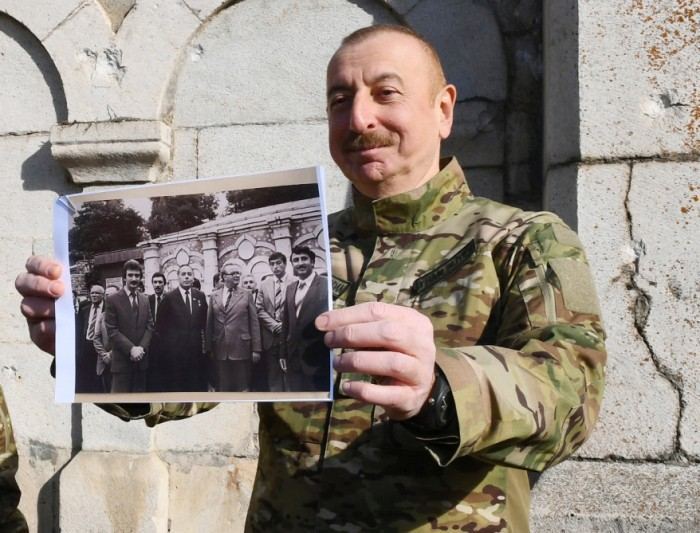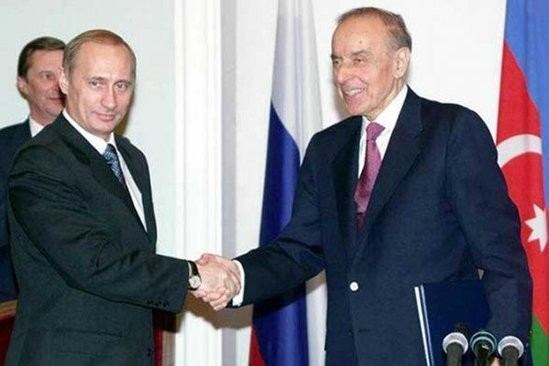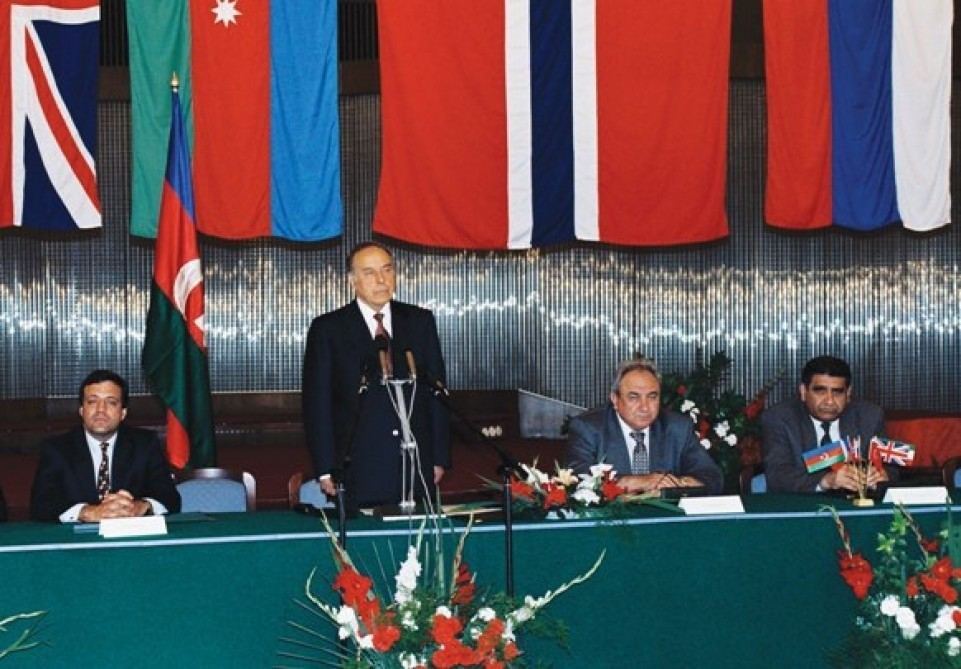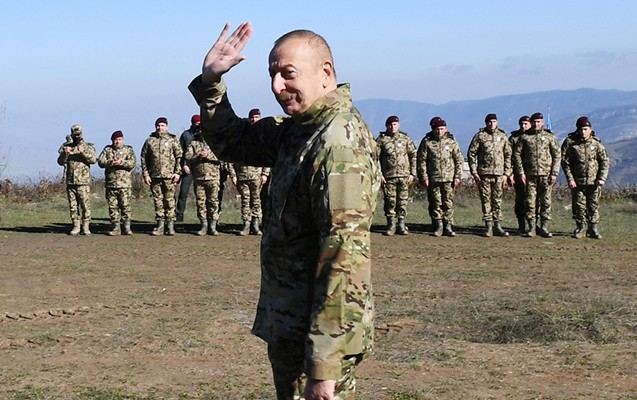Ceyhun Osmanli, former Member of Parliament, Researcher and Analyst on International Relations and Political Economy, Director of TLM – Initiatives and Projects Center in Azerbaijan, has published an article on occasion of 99th birth anniversary of great leader Heydar Aliyev.
Trend presents the article:
The ‘44-day War’ or the ‘Patriotic War’ between Azerbaijan and Armenia that depicted the strength of the Azerbaijani Army and ended with the decisive victory of Azerbaijan was the counter-offensive operation by the Azerbaijani Army, under the command of the Victorious Commander-in-Chief, President of the Republic of Azerbaijan Ilham Aliyev. The War started on September 27, 2020, as a countermeasure to the Armenian aggression against Azerbaijan and lasted 44 days. It ended the long-lasting occupation of the territories of Azerbaijan, which Armenia had captured in the wake of the First Karabakh War in the early 1990s. Thus, by December 1, Azerbaijan had restored its territorial integrity due to the decisive victory of Azerbaijan Army and as a result of the Trilateral Statement between Azerbaijan, Armenia, and Russia that was signed on November 10, 2020, right after the liberation of the Shusha, the cultural capital of Azerbaijan, by the Azerbaijani Army.
Liberation of the territories of Azerbaijan from Armenian occupation and restoring its territorial integrity was one of the biggest desires and policy priorities of National Leader Heydar Aliyev. Dedicating his life to the independence and state-building of Azerbaijan, the primary goal of Heydar Aliyev’s long-term activities during his presidential period from 1993-to 2003 was restoring the territorial integrity of Azerbaijan. In this regard, he highlighted, “Our main problem is to eliminate Armenian aggression against Azerbaijan, liberate our occupied lands, and ensure the republic’s territorial integrity.” Thus, National Leader stated on various occasions that “there is no Karabakh without Shusha, there is no Azerbaijan without Karabakh at all.” Therefore, he bequeathed this sacramental mission to Ilham Aliyev, the Victorious Commander-in-Chief and President of the Republic of Azerbaijan, who managed to fulfill his father’s will by liberation territories of Azerbaijan from Armenian occupation as the result of the ‘44-day War’. It is not a coincidence that during his ‘Address to the Nation’ in the Alley of Martyrs on November 8, 2020, after the liberation of Shusha, President Ilham Aliyev stated that, “Today, I also visited the grave of National Leader Heydar Aliyev and paid my respects. I said in my heart; I am happy to have fulfilled my father’s will. We have liberated Shusha! This is a Great Victory! The souls of our martyrs and the National Leader are happy Today!”

Heydar Aliyev encountered an insidious and dishonorable policy of Armenia toward Azerbaijan regarding the unification of the Karabakh region to Armenia first during his leadership of Azerbaijan SSR as First Secretary of the Central Committee of the Azerbaijan Communist Party between 1969-1982 and later in Moscow as First Deputy Chairman of the USSR Council of Ministers and member of the Politburo between 1982-1987. Since it was granted autonomous status in 1923, Armenia has spent significant effort to unify Karabakh region of Azerbaijan to Armenia. In the 1960s and 1970s, the Karabakh issue entered a new level that was inspired by the Khrushchevian ‘thaw’ after the death of Stalin. Armenia, on various occasions, applied the Center for the unification of the region to Armenia. However, while Heydar Aliyev was in charge in Azerbaijan and later in Moscow, Azerbaijan managed to prevent Armenian efforts by intervening in processes around the region. In this regard, during his speech in Parliament on February 23, 2001, the National Leader said that “...We paid more attention to the region that time, I repeat, to preserve Azerbaijan’s integrity and keep its territory intact. Even today, I admit to having done it to prevent Armenians from raising this issue repeatedly.”
However, Mikhail Gorbachev dismissed Heydar Aliyev from his position in the highest echelons of the Soviet power in 1987, officially on health grounds. His dismissal from his position gave Armenians a new momentum regarding the unification of Karabakh to Armenia or create second Armenian republic in the historical territories of Azerbaijan as a result of separatist movement. As a result, Armenian claims to the issue acquired a systematic nature, which outgrown into a full-scale war between Azerbaijan and Armenia after the dissolution of the Soviet Union in 1991 and the occupation of 20% of territories of Azerbaijan by Armenia.
Thus, today there is a strong believe in the Azerbaijani society that if National Leader Heydar Aliyev stayed in his position at the end of Soviet Union and became a leader of Azerbaijan since independence the situation will be totally different regarding the issue and Armenia will not have a chance and courage to began the war against Azerbaijan and occupy our territories. Therefore, when Azerbaijan was in turbulent situation in the summer of 1993 there was a demand in society for bringing Heydar Aliyev to the leadership of Azerbaijan. At the result, the leadership of Azerbaijan of that time invited Heydar Aliyev to Baku for consolidating the situation. Thus, National Leader Heydar Aliyev was elected as chairman of the Supreme Council of the Republic of Azerbaijan on June 15, 1993, and in same month he took presidential post of the Republic of Azerbaijan as acting President. Later on, in October 1993, Heydar Aliyev was elected as President of the Republic of Azerbaijan in a nationwide election.
After the election to the presidential post, National Leader played a significant role in the regulation process of the conflict between Azerbaijan and Armenia through the international and regional organizations. At the result of his continuous efforts, the topic became one of the most discussed issues by international organizations in the last decades of the twentieth century. During his presidency, Heydar Aliyev welcomed all peace-building initiatives in multilateral and unilateral forms. His main position regarding the resolution of the conflict was the restoration of territorial integrity. In this regard, he always stated that the territorial integrity of Azerbaijan would never be compromised in various stands.

As a great politician, Heydar Aliyev was aware of the actual situation regarding the conflict. Therefore, he accordingly reshaped his policy and started to implement a multifaceted strategy based on neutralizing the positions of pro-Armenian states, gaining support from states that were previously impartial, strengthening relationships with states and international organizations whose positions were closer to position of Azerbaijan, and pressuring Armenia through a multi-vectored diplomacy.
In the early period, he tried to pursue a balanced foreign policy among the regional states and establish bilateral relations with the United States and European Union (EU) countries. In order to neutralize the position of Russia toward the conflict, Heydar Aliyev made his first official visit to Russia and accepted to the membership of Azerbaijan within the Russian lead regional organization namely the CIS. As a result of the consolidation of bilateral relations with Russia, one of the world great powers with strong geopolitical interests in the South Caucasus, Heydar Aliyev managed to sign a ceasefire agreement with Armenian in Bishkek in 1994.

Heydar Aliyev was aware that strengthening the bilateral relations with the United States is significantly important for resolution of the conflict between Azerbaijan and Armenia. It is noteworthy to mention that the United States was one of the first countries that recognized the independence of Azerbaijan in 1992. However, because of the strong Armenian diaspora in its soul, strong bilateral relations based on the mutual interest of both countries could not be established since that time. In addition, Section 907 of the United States Freedom Support Act that was accepted in 1992 with the influence of Armenian lobby in 1992 bans any direct aid of the United States to the Azerbaijani government, which affected the relationship between the two states. Therefore, to attract the interests of the United States, Heydar Aliyev used the successful energy policy to change the approaches. As a result of establishing a positive attitude between the states, the companies of the United States were able to hold 40% of the shares of the exploitation of Azerbaijan oil through the “Deal of Century” that was signed on September 20, 1994.

The conflicting situation between Azerbaijan and Armenia was a threatening factor for the regional peace and stability and the energy projects that were going to carry energy resources from Azerbaijan to the Western market. Therefore, the United States began to be actively involved in the mediation process between Azerbaijan and Armenia. As a result, in 1997, it became one of the co-chair countries of the OSCE Minsk Group. In addition, due to the necessity of the involvement of Azerbaijan into anti-terror coalition, by the decision of the president George Bush of the United States, the implementation of the Section 907 was waived in 2002. Undoubtedly, the suspension of the Section 907 was the triumph of the successful foreign policy of National Leader Heydar Aliyev in relations with the United States.

After regaining its independence Azerbaijan has been looking ways to achieve closer cooperation with Euro-Atlantic region. Azerbaijan became full member of the OSCE and Council of Europe, as well as started collaboration with North Atlantic Cooperation Council (NATO) and EU within different programs.
Thus, one of the dimensions of multivector foreign policy of the Republic of Azerbaijan under the presidency of Heydar Aliyev was partnership with NATO. The landmark document within the establishment of substantive partnership between Azerbaijan and NATO was Partnership for Peace (PfP) Framework Document signed by President Heydar Aliyev on 4 May 1994. The political dialogue with NATO included a broad range of issues such as regional security, Armenia-Azerbaijan conflict, NATO-led peace support operations in Afghanistan and Iraq, emerging security challenges, as well as science, environment and public diplomacy.
The relations between Azerbaijan and EU are based on the 1996 EU-Azerbaijan Partnership and Cooperation Agreement that forms the legal basis for formal cooperation in all areas except the military, and defines the format of cooperation. The bilateral and multilateral formats of cooperation between Azerbaijan and EU enables Azerbaijan to exchange its views on issues of common interest, pursue its national interests in the context of regional policy and announce various initiatives. Despite the fact that EU was not directly involved in the resolution of former Armenia-Azerbaijan conflict, it always supports territorial integrity and inviolability of international borders of Azerbaijan, as well as expresses respect for its state independence and sovereignty. Today, Azerbaijan highly appreciates the role of EU in the post conflict normalization, as well as finalizes the work on new agreement with EU that absorbs new realities after the Second Karabakh war, and definitely will continue a comprehensive cooperation, the successful launch of which was established during the presidency of great leader Heydar Aliyev.
Heydar Aliyev also recognized the mediation role of the OSCE and accepted it as a platform for stressing the positions of Azerbaijan in the conflict. In particular, the 1996 OSCE Summit in Lisbon played a crucial role in Heydar Aliyev’s diplomacy regarding the conflict. Although the principles offered by Azerbaijan for the solution of the conflict were not included in the final document of the summit due to protest of Armenian side, the principle of the solution of the conflict within the territorial integrity of Azerbaijan was accepted by most of the participating states.

Later, the OSCE Minsk group proposed such peace projects as a “Package deal,” a “Step-by-step deal,” and a “Common state.” While Heydar Aliyev accepted the “Package deal” and the “Step-by-step deal” proposal, the “Common State” proposal was rejected because it challenged Azerbaijan’s national interest. In 1999 and 2001, bilateral meetings between Heydar Aliyev and Robert Kocharyan were organized in Washington, Paris, and Key West. However, those meetings, unfortunately, did not contribute to resolving the conflict due to the destructive policy of Armenia regarding the issue.
Overall, during his presidency, National Leader Heydar Aliyev managed to get the international community to understand the position of Azerbaijan, promoted true arguments about the war, achieved a ceasefire agreement that stopped the violence between the countries, convinced international organizations to include the Karabakh issue between Azerbaijan and Armenia on their agendas, and participated in several multilateral and unilateral initiatives to resolve the conflict, which strengthened the position of Azerbaijan and set the legal basis for the resolution of the conflict later.
Today the President of the Republic of Azerbaijan Ilham Aliyev is a well-deserved successor of the National Leader Heydar Aliyev’s way. The biggest dream of the National Leader Heydar Aliyev celebrating the 99th birth anniversary this year has finally come true. Azerbaijan has restored sovereignty over its internationally recognized territories under the command of the Victorious Commander-in-Chief, President of the Republic of Azerbaijan, Ilham Aliyev.
The wise political heritage of Heydar Aliyev lives and succeeds in today’s modern Azerbaijan.







